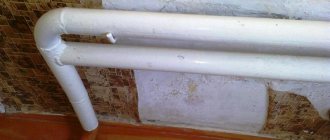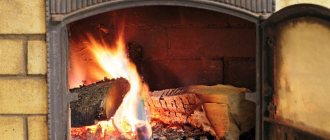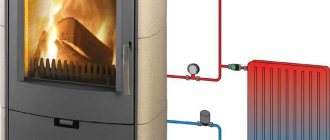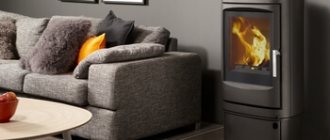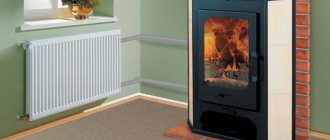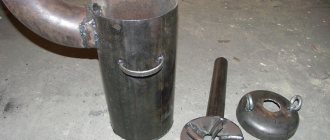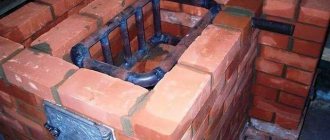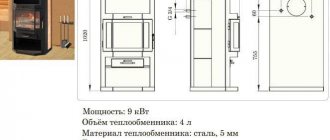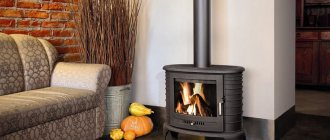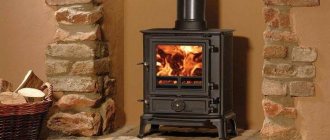- Power
- Connection to the heating system
This is one of the firebox appliances that has retained its popularity due to its exceptional decorative design. For buildings located outside the city limits and in populated areas without laid communications, stoves are still the main source of heat in the home. Let us clearly consider all the conveniences and advantages of choosing and installing a fireplace stove with a water circuit for heating.
Principle of operation
The unit is a hybrid of a conventional stove, boiler and fireplace. The circuit for heating water can be made of separate register pipes located in the firebox or along the walls. Another alternative is that the coolant circulates inside two partitions in the housing; this design is called a “jacket”.
Less often, a water heating tank is placed in the upper part; this is a less effective solution.
Each element is directly connected to the overall space heating system. Due to thermal conductivity, you can warm several rooms at once.
Such devices operate according to the same algorithm, since they are aimed not only at providing housing with heat, but also with hot water supply.
- The boiler heats the liquid, which flows through pipes using electric pumps.
- The cooled coolant is returned for further heating.
Features of connection to the heating system
A water fireplace is connected to the system if there is a coolant in the circuit, taking into account its circulation.
Natural type of circulation
Location of pipes with forced and natural circulation
Units with a water circuit are connected as follows:
- Construction of an accelerating manifold behind the heat exchanger to raise the coolant to the highest point.
- Installing the expansion tank at the top.
- Construction of a heating main from pipes of at least 32 mm in diameter.
- Maintain a slope of 5 cm per 1 m for normal circulation.
Forced circulation type
Forced water circulation provides several nuances:
- the expansion tank is placed on any section of the highway;
- batteries can be connected in any way;
- It is not necessary to observe the slope of the route;
- To prevent condensation from appearing in the firebox, you can use an automatic unit.
Advantages of fireplace stoves
Among the main advantages of using such equipment, several points stand out.
- Creating a pleasant indoor environment.
- High heating rate.
- Possibility to combine with existing heating systems.
- Arrangement almost anywhere, the main thing is to comply with fire safety rules.
- Easy to use with heat exchangers, absolute autonomy.
- Work from an accessible and inexpensive type of fuel.
- Multifunctionality. This is both a heating device and equipment for cooking.
Review of popular models
The easiest to install and connect are considered to be free-standing devices made of steel and cast iron with a built-in heat exchanger. They can be located in a double housing, creating a water jacket around the camera, or located in the upper part of it. The pipes brought outside are simply connected to the heating circuit. For the heating device itself, it is enough to find a convenient place in any area of the room where the chimney can be removed. The main thing is not to forget to cover the floor with a metal screen over a non-flammable coating (minerite sheet, for example).
Stove-fireplace AQUA
They are made of steel in the form of 5 mm plates. The transverse edge and chambers are covered with heat-resistant tiles, which can be replaced if damaged.
The product includes a tempered glass door for viewing. There is a niche for firewood at the bottom.
Specifications:
- energy supply ranges from 13 to 16 kW;
- the circuit gives a power indicator of 5-7 kilowatts;
- steel heat exchanger;
- designed for wall installation;
- the lining of the side walls is made of ceramics;
- the front panel has panoramic heat-resistant glass;
- chimney diameter – 150 mm.
Even if there is no connection to the heating system, the ability to warm up the space is not lost. Only this method increases wear. It is imperative to fill the circuit with water when turning it on, otherwise the elements will be damaged and they will fail.
Bavaria fireplace stove
Manufactured from steel sheets, complemented by a cast iron grate to separate the firebox and ash pan. Experts note good technical characteristics:
- compact size - the device is suitable even for small spaces:
- mobility – the fireplace stove can be moved from one place to another at the owner’s discretion;
- the units are easy to install and use;
- strong heat-resistant glass ensures safety by reducing the risk of flame entering the room;
- warm-up speed is very high;
- fairly high productivity (efficiency - 80%);
- environmental friendliness - carbon dioxide emissions are reduced and barely reach 0.20%;
- if you purchase a model that has a built-in hob and oven, you can cook food over an open fire by first removing the cast iron rings from the burners;
- Externally the devices are very attractive.
Devices with a water circuit are connected to pipes in all rooms of the house. On top of the chamber or in the partitions of the stove there is a heat exchanger with a coil through which the liquid coming from the distribution tank moves. On both sides, pipes diverge along the edges to supply cold and hot water, which have the property of removing boiling water that gets into the heating system. To determine whether the stove will perform its functions fully, you need to evaluate the power factor.
Product lines
The Angara series of fireplace stoves is presented on the Russian market in several versions: standard, with a heat exchanger and/or stove, as well as with increased dimensions.
1. Angara fireplace stove standard.
Specifications:
- A 9 kW oven heats rooms up to 90 sq.m.
- Dimensions – 1020×560×490 mm.
- Weight – 140 kg.
- Location – corner/front.
The basic model does not require a reinforced foundation. Small dimensions and wall placement allow homeowners to maintain enough free space in the room. Parts of the side surfaces of the furnace body are lined with ceramic tiles. The combustion chamber is lined with fireclay tiles on the inside. This protects the steel walls from burning out and increases the service life of the furnace. There are also cast iron grates inside, through which ash and ashes fall into the drawer. Below the firebox there is an open chamber for storing firewood. One stack of fireplace stoves consumes 3-4 kg of fuel. The burning time is about 4 hours. The strength of the flame is regulated using slide valves.
2. MetaFire Angara 12 series fireplace stove with stove.
Specifications:
- Heating area – 100-120 sq.m.
- Thermal power – 12 kW.
- Dimensions – 950×700×545 mm.
- Weight – 195 kg.
- Location – frontal.
The new stove features a larger combustion chamber volume and an improved heat exchanger. The extended functions of the model are manifested in the presence of a plate. The ability to simultaneously use a fireplace stove to heat the house and cook food brought Angara 12 into the ranks of top products.
3. Stove-fireplace with water circuit Angara Aqua.
Specifications:
- Heated area – up to 210-230 sq.m.
- The total thermal power is 18 kW.
- The water circuit capacity is 9 kW.
- The volume of the heat exchanger is 4 liters.
- Dimensions – 1020×550×490 mm.
- Weight – 150 kg.
A stove with a water circuit, Angara Aqua, heats the house using radiators. It is used in open/closed heating structures with forced/hydraulic coolant circulation. The original device and front placement provide accelerated heating. Softened water or antifreeze liquid can be used as a coolant. The fireplace is equipped with a door with heat-resistant glass “Neoceram NO” and a “clean glass” system.
For uninterrupted operation of the furnace, it is necessary to use coarse filters, safety structures and air vents. It is advisable to install thermostats on radiators. The Angara Aqua fireplace can be heated independently, without connecting to the water circuit. The system must be full. The heat exchanger operates stably under such conditions, but its service life is significantly reduced.
4. Meta Angara 12 Aqua fireplace stove with water heat exchanger.
Specifications:
- Heated area – 140-160 sq.m.
- Productivity – 16 kW.
- Dimensions – 1040×700×535 mm.
- Weight – 205 kg.
- Heat exchanger volume – 10 liters.
- Location – wall.
The water loop furnace is a new heating device with improved characteristics. The heat exchanger system ensures high combustion efficiency and reduced soot volume in the chimney. The large dimensions of the fireplace allow the use of large firewood. Decorative ceramic elements are used in the design of the stove lining. The combustion doors have a prismatic shape and are made of heat-resistant glass ceramics.
Choosing a fireplace stove - what to look for
When a room is not heated well enough, dampness and mold appear, which negatively affect interior items and also cause damage to metal products. To avoid such problems, it is necessary to carefully study the features of this type of equipment at the selection stage. There are many differences between them in terms of:
- power class (wood, electricity, gas);
- method of location (to the wall, in the corner, built-in, separate);
- functionality (classic, fireplace, barbecue);
- firebox (open or closed);
- chamber material (cast iron, steel, inset).
When selecting a heating device, the owner must decide:
- with type of fuel;
- how many rooms will the unit be needed and where will it be located;
- what the chimney should look like and where to install it.
Power
As a rule, the larger the structure, the more it needs more radiators. The fundamental difference between a standard stove or fireplace is that the manufacturer indicates two values: the total thermal power and the heating device itself.
For an average three-room house with parameters of 80 m2, it will be reasonable to install a 6 kW device. Another way to calculate the approximate power: a 10 m2 room with a ceiling height of up to 2.6 m needs 1 kilowatt-hour to heat.
Using the same scenario, you can determine how much fuel is consumed on average. To do this, the following data is taken: 1 kg of hardwood logs with a moisture content of no higher than 20% supplies approximately 3.5 kilowatts of heat.
Material: steel or cast iron
Steel products are lighter, so they can be easily installed directly on the floor. They are not afraid of sudden changes in internal temperatures; the devices tolerate mechanical stress well.
However, they have a significant problem with the thickness of the walls: due to the thinness, there is a risk of corrosion occurring in a short time. After the fire and coals have gone out, the stove cools down quickly.
Cast iron devices have thick partitions and heavy weight, so when purchasing certain models you will have to prepare a foundation. This option is only possible if there is no concrete floor on the first floor. But cast iron is not at all prone to corrosion and provides heat for a long time after being turned off.
The negative aspects include the poor resistance of the material to sudden temperature changes. If this happens, the product may burst. Also, the heating device is quite fragile and cannot withstand strong shocks, which complicates its transportation and further operation.
Rating of TOP 10 best models
In this rating, we have collected for you the best models in terms of price, quality and reliability.
La Nordica Termo Isotta
The Isotta cast iron stove is equipped with a water circuit and is designed to heat several living
spaces at the same time .
Its double walls allow you to effectively manage air flow. A hob is built into the surface. It has a protective cover that protects the walls from contamination during the cooking process.
The firebox door is decorated with panoramic ceramic self-cleaning glass . There is a separate door at the bottom for easy use of the ash drawer.
Characteristics:
- power: 15-19 kW;
- Efficiency: 78.4%;
- location: wall;
- chimney: 150mm, front/rear;
- material: cast iron;
- glass type: panoramic;
- dimensions: 77.5*76*52cm;
- weight: 212kg.
Advantages:
- long burning;
- convenient door;
- self-cleaning glass;
- moderate fuel consumption.
Flaws:
- No.
META Angara Aqua
The total power of the model is 16 kW, of which 7 kW is the power of the water circuit . Heat exchanger holds 10 liters
liquid and is made of 5 mm steel. The firebox has a significant volume and is easy to clean from combustion products.
Firewood can burn in a prolonged mode, which is especially convenient at night.
The body is decorated with ceramic inserts, and the glass door provides excellent visibility..
Design solutions made it possible to reduce the volume of soot entering the chimney.
Characteristics:
- power: 16 kW;
- location: corner/wall;
- chimney: 150mm, front/rear;
- material: steel;
- heated area - up to 160m2;
- glass type: prismatic;
- dimensions: 104*70*54.5cm;
- weight: 205kg.
Advantages:
- attractive external design;
- presence of panoramic glass.
Flaws:
- high fuel consumption;
- insufficient heat transfer to the coolant;
- soot on the glass.
EdilKamin Aqua
The combustion chamber of this furnace has double walls . This allows you to reduce the temperature impact on the case and extend the service life.
stove-fireplace services.
The inside of the firebox is lined with fireclay, resistant to combustion products and high flame temperatures.
The door is decorated with glass, which can withstand heat up to 750 degrees, but is not resistant to pinpoint impacts . The water circuit will allow you to create a full-fledged heating system in the house, heating the neighboring rooms.
For safety, there is a built-in sensor against system overheating . The oven can be used in the kitchen; the cooking surface has a heating temperature of up to 200 degrees.
Characteristics:
- power: 6.5 kW;
- hob;
- location: wall;
- chimney: 150mm, ;
- material: steel, ceramic tiles, fireclay;
- glass type: straight;
- dimensions: 95*52*52cm;
- weight:186kg.
Advantages:
- high quality materials;
- excellent assembly;
- overheat protection.
Flaws:
- No.
Vesuvius PK-01(270) BEIGE
The stove is made of a combination of cast iron and steel . The door is cast iron with heat-resistant glass. The grate is cast iron. Firebox
trimmed with chamotte.
The ends are decorated with beige ceramic inserts, which help the stove retain heat longer. It is possible to heat rooms with a total area of up to 200 m2.
Burning time on one stack of wood is up to 5 hours.
High-quality components guarantee a service life of at least 10 years. The furnace firebox is 100% airtight.
The parts are fixed using a bolted connection to guarantee reliability . In the economical operating mode, the firewood only smolders; in the intensive mode, quick kindling is carried out.
Characteristics:
- power: 9 kW;
- hob - no;
- location: wall;
- heating area - up to 200m2;
- chimney: 150mm, ;
- material: steel, cast iron, ceramic tiles, fireclay;
- glass type: straight;
- dimensions: 82*46*43cm;
- weight:141kg.
Advantages:
- design;
- ergonomics;
- holds temperature for a long time.
Flaws:
- No.
Vesuvius PK-01(270) RED
The fireplace stove is made from high quality induction steel . The firebox door is made of cast iron and equipped with glass
insert, the blower door allows you to control the intensity of combustion.
The firebox is finished with high-quality fireclay, which can be easily replaced if necessary. Decorative inserts on the sides are ceramic, red.
The power is 9 kW, which will allow you to warm up a room with a volume of up to 150 m3.
One stack of firewood will provide heat for up to 5 hours. You can connect an electric fan to quickly heat the room. The minimum service life of the product is 10 years.
Characteristics:
- power: 9 kW;
- hob - no;
- location: wall;
- heating area - up to 200m2;
- chimney: 150mm, ;
- material: steel, cast iron, ceramic tiles, fireclay;
- glass type: straight;
- dimensions: 82*46*43cm;
- weight:141kg.
Advantages:
- heating rate;
- nice design in a classic style;
- high legs.
Flaws:
- soot on glass.
How to choose a wood-burning stove-fireplace with a water circuit for heating
The leading positions in the market are still retained by units operating on traditional fuel – wood. These are relatively inexpensive products with a familiar design.
To keep up with rising demand, manufacturers have to follow new trends and apply innovative technologies. Taking this fact into account, various changes are being made to the models.
Basically the devices are available:
- ash box;
- firebox
Additionally, you will have to purchase a chimney and other auxiliary elements.
There are two modes of use:
- long burning;
- intensive.
It is possible to purchase products with modifications: for example, the chamber can be protected with a layer of vermiculite or fireclay brick, which increases service life.
Special cast iron circles or an entire hob (cast iron, glass ceramics) can also be installed. Some stove modifications have a decorative lid that covers the cooking surface when not in use.
Power selection
Without knowing what the building's heating needs are, selecting equipment is difficult. The calculation can be approximate and accurate. The first option is preferred by sellers of heating equipment, as it provides a relatively accurate result. In this case, the thermal power is calculated in accordance with the area of the premises that are heated.
They look at a single room and find out what area it has. The resulting value is multiplied by 120. The energy required for the entire country house is determined after combining the indicators of all rooms. But the exact method is much better. It assumes:
Multiplying the area of premises where only one wall is in contact with the street by 100
It is important that there is one window on the same side. Multiply by 120 if we are talking about a corner room with one window. Multiply by 130, when we mean a room with two or more windows, as well as two external walls. When calculating using an approximate method, residents of cold regions may not receive enough heat, while those living in the south may overpay for overly powerful equipment.
In this video you will learn how to make a heat exchanger:
The exact calculation method is carried out by specialists. It provides a clear understanding of how much heat can be lost in any building. Before proceeding with specific calculations, determine the area of doors, windows and walls. Each building material has one layer thickness or another. It also needs to be taken into account.
Installation of stove-fireplace + video
In order to protect yourself and your home from dangerous situations, the installation of fireplaces must be carried out in strict accordance with the regulations and in compliance with the correct technology.
First of all, a project is developed, then work is carried out in the following sequence:
- preparation of the base (insulation with a number of bricks or 12 mm metal sheet);
- installation of a cast iron firebox;
- laying a smoke exhaust pipe;
- portal device, external cladding.
Modern metal products do not require much time to equip. The main rule that must be followed is: place the stove away from the walls (20-30 cm), even if it is lined with non-flammable material.
The apparatus does not require a foundation, only a low base lined with fireproof elements (minerite sheet, steel or tile).
Connection to the heating system
There are two installation schemes:
- from scratch";
- into an existing unit.
To implement the second option, you will have to put in more effort; you need to disassemble the fireplace stove, design and select the correct design and dimensions of the heat exchanger, and then correctly put everything back together.
The device with a water jacket has different connection schemes:
- open is implemented under a pressure of about 1.5 bar, and the wall thickness of the connected pipe must correspond to 4 or more millimeters;
- closed can withstand 2.5 atmospheric pressure with a partition of 6 mm.
If the structure is organized according to a natural circulation system, then a situation with liquid boiling cannot be ruled out. To avoid this, you will have to install a pump.
Device Features
A fireplace stove with a built-in water circuit is a steel chamber with varying wall thicknesses . In a closed system the indicator will be 6 millimeters, in an open system - 4 millimeters.
Heat exchanger tubes are mounted between the walls to circulate the coolant liquid. To be able to control the temperature in the oven, temperature sensors are installed.
The air flow into the combustion chamber is usually adjusted manually.
PLEASE NOTE! Exterior decoration can be made using various materials in order to fully comply with the overall style of the interior.
In summer, such equipment can only be used for water heating.
Requirements for chimneys
To be sure of the safety of a fireplace stove with a water heating boiler, you need to carefully approach the choice of every detail. It would be preferable to install a chimney duct made of ceramics or stainless steel produced by FERRUM, which can withstand temperatures up to 600 ºC. When passing ceilings and walls, roofs and outlets to the street, it is necessary to use insulated sandwich pipes, which prevent the formation of condensation and increase the fire safety of the passage of floors and are resistant to burnout. Ceramic chimneys are very expensive and their installation is also time-consuming and expensive. We recommend choosing FERRUM stainless steel chimneys. Regardless of which pipe was chosen, you must adhere to the established regulations.
- The diameter must be equal to the diameter of the pipe. It is possible to increase it up to 30% with the help of adapters, but it is absolutely impossible to narrow it.
- To regulate the draft and prevent cold air from getting inside, it is necessary to install a damper or valve.
- The permitted distance for horizontal sections that provide stable traction is one meter.
- Total chimney height. As a rule, this value is within 5 m.
- To pass ceilings, it is necessary to use polyurethane foam with mineralite produced by FERRUM. The chimney itself must be double-walled - a sandwich.
- It is necessary to provide access to the chimney for regular cleaning, as well as a condensate trap.
Installation and installation
You should entrust the installation work to specialists and not take risks by installing it yourself.
- After a thorough inspection of the fireplace, you should ensure the integrity of the parts and the strength of the connections.
- The device is installed on a 30-40 cm foundation.
- The device should be leveled and connected to the chimney ducts and water system. According to consumer reviews, this procedure is not difficult.
- The next step is the installation of the components, according to the instructions for each individual model, which can be seen in the video.
The standard connection model for most fireplaces with a water jacket is approximately the same:
- install the fireplace itself in the basement or living room;
- a hydraulic accumulator is installed in the utility room,
- Radiators are installed along the internal perimeter of the house to heat the room.
The placement of the expansion tank changes the type of system, which, depending on its location, can be closed or open:
- An open system is characterized by placing the expansion tank at the highest point of the room; the heat exchanger, located in the free part of the firebox, is located in the coil and is filled with water under the influence of gravity. Such a system is simple, you can easily install it yourself, but due to the large energy loss of water and the high hydraulic pressure of the pipes, it is ineffective.
- With a closed system, the heat exchanger is located in the closed part of the fireplace, and a pump is used to circulate water in the system. Water boils when circulation stops, causing an emergency shutdown of the equipment. Such a system is much more difficult to assemble yourself
To prevent this phenomenon, an additional coil is installed in the rear of the device, which is filled with cold water if necessary. A water temperature sensor is built into the water jacket of such fireplaces, and if it overheats, the system automatically turns off.
Fuel requirements
Hornbeam, oak, birch or aspen logs are ideal for lighting the stove. When burning, they emit less soot and smoke.
You should not buy coniferous wood, cherry, willow and elm. They are characterized by a large amount of resin and soot. Logs can produce sparks, which increases the risk of fire and negative impact on human health.
Firewood should be lit with birch bark, wood chips, paper products or a special liquid. It is imperative to ensure that during the process the gate valve is open all the way and that there is sufficient aeration in the ash pit.
By the way, the usual wood-burning stoves-fireplaces are far from the only type. For some time now, they have been in no way inferior in popularity to gas, electric analogues and those that run on special biofuel.
Electric and liquid fuel
Electric heating is considered the most efficient. Only it can provide 99% efficiency. In addition, it does not require ventilation or chimneys; maintenance as such is not provided, unless there is a need to clean the device every 2-3 years.
Installation, like the cost of the equipment itself, is cheap. Of course, all these properties of an electric boiler make it attractive in the eyes of the buyer, but it is still not cheap. Financial costs are due to the need to pay for electricity. You can install a multi-tariff meter, although this will not allow you to bypass a wood-burning heat generator in terms of functional characteristics.
Liquid fuel boilers operate on diesel fuel and waste oil. This type of heating is considered the dirtiest. After visiting the boiler room, you will certainly have to wash your hands of diesel fuel. Also, the clothes will emit a corresponding smell. The unit will need to be cleaned once a year. This is a separate event, after which you will have to wash off the soot from almost your entire body. The use of diesel fuel is not the most profitable solution. Its cost can cancel out all the obvious advantages. Used oil has now risen in price and can only be beneficial to those who have a cheap source.
https://youtube.com/watch?v=d0idwQchW3s
Modern heating boilers contain many important elements. Among them is a heat exchanger for a brick kiln with welded plates. It is inside it that heat is transferred to the carrier from the generator. Today there is a large assortment of different heating boilers, but this does not prevent owners of private households from making such devices on their own.
Operating rules for furnaces
When using a fireplace with water heating for your home, you should not:
- use other types of fuel not intended for the selected model;
- use flammable flammable liquids for kindling purposes;
- add firewood that is much larger in size than the dimensions of the chamber;
- ignore the appearance of cracks on glass surfaces;
- use the elements of the device to dry clothes or other materials;
- place objects that could ignite from close contact closer than 1.5 meters from the heated surface;
- overfill fuel storage areas with logs and things that can catch fire;
- overload the chamber by adding excessive amounts of firewood;
- extinguish the flames inside with water;
- attempt to remodel the fireplace stove yourself or use it for other purposes;
- remove not yet extinguished coals and ash;
- leave a working device unattended;
- block smoke ducts while wood is burning.
Under no circumstances should children be allowed to operate the device.
Typical diagrams for connecting a fireplace to a heating system
Gravitational convection.
To maximize the efficiency of the fireplace and effectively distribute the heat generated in its combustion chamber throughout the house, it is necessary to integrate the fireplace into the heating circuit of the house (in the case of a fireplace in a water jacket). Fireplaces with air ducts require special design of heating elements.
The air heating scheme of a fireplace depends on the area of the serviced area. So, gravity wiring is suitable if the area of the room that needs heating is very small. The length of the air ducts should not exceed 3 m in length. In this case, the air heated by the fireplace will rise through the channels, displacing cold air at the ends of the pipes.
Forced convection.
This circuit is completely energy-independent, easy to design, install and use. Requirements for its installation: the length of the air ducts should not exceed 5 m, the pipe itself should be level with a minimum number of turns. The structural material of the pipes should be fireproof aluminum capable of withstanding temperatures of 250°C. Thermal insulation of the air duct housing is mandatory.
A circuit with forced air movement, although more expensive to implement, compared to its gravitational counterpart, allows you to heat a larger area of the room. At the same time, the efficiency of the system will not be affected by the complex layout of the house. In addition to air ducts, this circuit is equipped with elements of supply ventilation (as the main driving mechanism of warm air), connecting nodes and corners, and various elements for controlling directional air flows.
